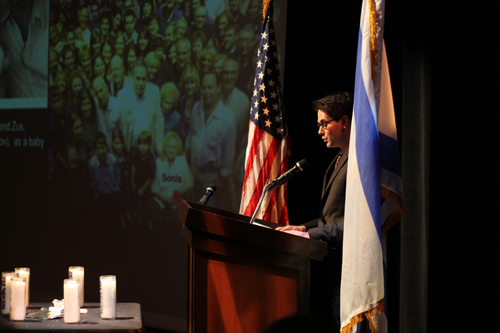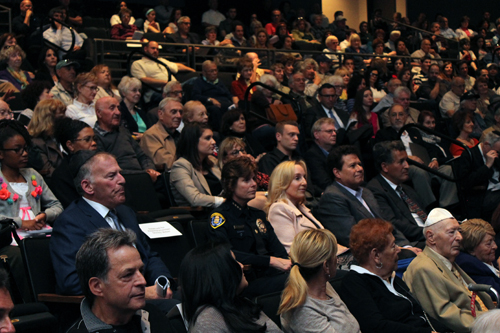Don Harrison of San Diego Jewish World reports below:
 |
| Elan Bielski, grandson of one of the partisan Bielski Brothers, addresses Yom HaShoah commemoration on Sunday, April 27 |
SAN DIEGO – San Diego’s communal Yom HaShoah observance on Sunday, April 27, focused on the Jews who met the Nazi scourge with “Defiance, Rebellion, Resistance,” including, but not limited to, the Jewish partisans who actively waged guerrilla warfare against the Germans.
The featured speaker at the commemoration in the Garfield Theatre of the Lawrence Family JCC was Elan Bielski, an American Israeli whose grandfather Zus was one of the three Bielski brothers whose exploits as partisans in a forest of Belarus was celebrated in the movie Defiance. Along with his two brothers, Zus Bielski was credited with organizing a hidden forest community in which more than 1,200 Jews successfully evaded capture by the Nazis.
While the Bielskis were successful in their efforts to protect Jews living with them in the forests, armed resistance to the Nazis in other instances could be counter-productive, Roman Kent, chairman of the American Gathering of Jewish Holocaust Survivors, said in a videotaped address. “Many times the consequences of taking a gun and shooting a German would be they would take hundreds of people and kill them,” Kent said.
 |
| Andrew Viterbi Addressing Audience |
There were other ways to resist, he said, such as workers who slowed down production in Nazi factories, or “the mother who gave a piece of bread to the child so that he could survive” or the ghetto symphony orchestra which played, despite bitter cold, and “gave the people the will to live another day” and the teacher who taught children in the ghetto. “There were many other points of resistance,” said Kent.
Agreeing with this analysis was Andrew Viterbi, honorary chairman of the event as well as a scientist who was a co-founder of Qualcomm. He said that Jews defied their Nazi captors day in and day out.
“Many rebelled by observing Jewish rituals and holidays as fully as possible until they were no longer able to do so,” Viterbi said. “In the ghettos, some resisted by establishing schools for children, and presenting lectures and programs for adults. Others created art, literature, music and poetry…. Some resisted by staying alive, others by dying with the shm’a on their lips.”
As a lead-in to Viterbi’s introduction of young Bielski, Bernardo Bicas led a crowd that included such public officeholders as Congressman Juan Vargas, State Senator Marty Block and San Diego Police Chief Shelley Zimmerman in the singing of a Yiddish “Partisan Song” with a title translated as “Never Say.”
Having grown up on Long Island, New York, young Bielski joined the Israel Defense Forces following a visit to Israel on a Taglit/Birthright program. The young man shared that his brother Matt already was serving at the time in an elite unit of the IDF. When Matt paid a visit to the Birthright group, he immediately “picked up” the prettiest girl and, quipped Elan, “I knew I wanted to be in the IDF.”
Actually Elan followed not only his grandfather, but his father,and brother into the business of defending the Jewish people, his father also having served in the IDF after completing a hitch as a U.S. Marine.
One reason the Bielskis brothers were so successful in hiding their fellow Jews during World War II was that they often had made recourse to the forest before the war to elude the anti-Semites of their town, Stankevich, where they were members of the only Jewish family. Starting with 10 people, their numbers grew to 30 and then to 300 and up as they established their “Jerusalem in the woods,” Elan said. The community hidden deep in the forest was nearly self-sufficient and included tailors, shoemakers, synagogues, hospital, and even a jail. Their guerrilla fighters sabotaged 34 trains, 78 bridges and killed 400 enemy fighters before Soviet troops cleared the area of the Nazi enemy.
This year’s Yom HaShoah program paid tribute to other forms of defiance as described by Viterbi. For example the Miryam Quartet of Eileen Wingard, her daughter Myla Wingard; and the sisters Dorothy Zeavin and Marcia Bookstein, performed music composed in Theresienstadt, including Lied Ohne Worte (Song Without Words) and Uv’Tzeil K’Nofecho (In the Shadow of the Wings). Sam Brogadir, accompanied by Andrew Mayer, sang Shtiller, Shtiller, a song composed by an 11-year-old boy who rued the many Jews who were marched by the Nazis to the Ponar Forest, near Vilna, where they were executed.
On video, there was also a poetry reading by survivor Itka Zygmuntowicz, who wrote:
I feel like a bird with clipped wings
tied to this earth by invisible strings
chained to a destiny I did not choose
I feel like a prisoner that cannot break loose
I look to the sky with a heavy sigh
but my wings have been clipped and I can no longer fly.
Other parts of the program followed traditional patterns for community Holocaust commemorations, with second generation members Barbara Ostroff, chair of the Yom HasShoah Committee. welcoming the crowd numbering in the hundreds; and Jack Morgenstern introducing the Marine Corps Recruit Depot Color Guard, which presented the colors. Sierra Lieb sang the “Star Spangled Banner” at the beginning of the program. At the end of the program “Hatikvah” was sung by a choir that included members of the J*Company performance company, Ohr Shalom Religious School, and Shevet Galim –Israeli Scouts of San Diego.
There also was the lighting by Holocaust Survivors and Second Generation members of six candles, each representing one million of the six million Jews murdered by the Nazis. In a ceremony, narrated by Hanna Marx, president of the New Life Club of Holocaust survivors, Pearl Recht lit the shamash candle, with which the other six candles were lit. Called up for the ceremony were Michael Bart, Max Landau, Morris Liebermensch, Ben and Esther Midler, Max & Rose Schindler and Morris Schwartz.
In another brief address, Steven Klappholz, a former director in San Diego of the Jewish Community Relations Council, told of the work of his current employer, the USC Shoah Foundation, founded by movie producer Steven Spielberg with the proceeds from the Holocaust movie Schindler’s List. Klappholz said that the USC Shoah Foundation has collected 52,000 testimonies from survivors living in more than 30 countries. Over 300 videotaped testimonies were collected in San Diego County alone, thanks in part to Erna Viterbi and Phyllis Epsten, local co-chairs of the Friends of the Shoah Foundation. Klappholz said over 200,000 students in San Diego County have been exposed to the videotaped testimonies, and 1,600 teachers in this area have undergone training in the use of these resources.
As the ceremony neared its conclusion, Rabbi Philip Graubart of Congregation Beth El led the crowd in prayers and responsive readings suited for the occasion as well as in the Kaddish, which originally Survivor Lou Dunst had been scheduled to lead, but was unable to do so. Rabbi Rafi Andrusier of Chabad of East County chanted the traditional song of mourning, “El Moleh Rachamim” and the ceremony was closed by Michael Sonduck, president and CEO of the Jewish Federation of San Diego.
In another brief address, Steven Klappholz, a former director in San Diego of the Jewish Community Relations Council, told of the work of his current employer, the USC Shoah Foundation, founded by movie producer Steven Spielberg with the proceeds from the Holocaust movie Schindler’s List. Klappholz said that the USC Shoah Foundation has collected 52,000 testimonies from survivors living in more than 30 countries. Over 300 videotaped testimonies were collected in San Diego County alone, thanks in part to Erna Viterbi and Phyllis Epsten, local co-chairs of the Friends of the Shoah Foundation. Klappholz said over 200,000 students in San Diego County have been exposed to the videotaped testimonies, and 1,600 teachers in this area have undergone training in the use of these resources.
As the ceremony neared its conclusion, Rabbi Philip Graubart of Congregation Beth El led the crowd in prayers and responsive readings suited for the occasion as well as in the Kaddish, which originally Survivor Lou Dunst had been scheduled to lead, but was unable to do so. Rabbi Rafi Andrusier of Chabad of East County chanted the traditional song of mourning, “El Moleh Rachamim” and the ceremony was closed by Michael Sonduck, president and CEO of the Jewish Federation of San Diego.
 Mention was made during the program of Holocaust-related books written by San Diego County residents that may be found in the Samuel and Rebecca Astor Judaica Library inside the Lawrence Family JCC on the Jacobs Family campus.
Mention was made during the program of Holocaust-related books written by San Diego County residents that may be found in the Samuel and Rebecca Astor Judaica Library inside the Lawrence Family JCC on the Jacobs Family campus.
These included Because of Romek: A Holocaust Survivor’s Memoir by David Faber; Dear Cara: Letters from Otto Frank by Cara Weiss Wilson; From Barbed Wire to Picket Fence: A Child Holocaust Survivor’s Dreams and Adaptability by Teresa Fischlowitz; I Am Lubo by Lou Pechi; My Bargain with God: The Story of Holocaust Survivor Lou Dunst by Rabbi Ben Kamin, and Until Our Last Breath: A Holocaust Story of Love and Partisan Resistance by Michael Bart and Laurel Corona.
When the ceremony concluded, departing guests took stones from baskets to place at the Holocaust memorial adjacent to the front entrance of the JCC at 4126 Executive Drive in the eastern portion of the La Jolla neighborhood.
When the ceremony concluded, departing guests took stones from baskets to place at the Holocaust memorial adjacent to the front entrance of the JCC at 4126 Executive Drive in the eastern portion of the La Jolla neighborhood.



0 comments:
Post a Comment